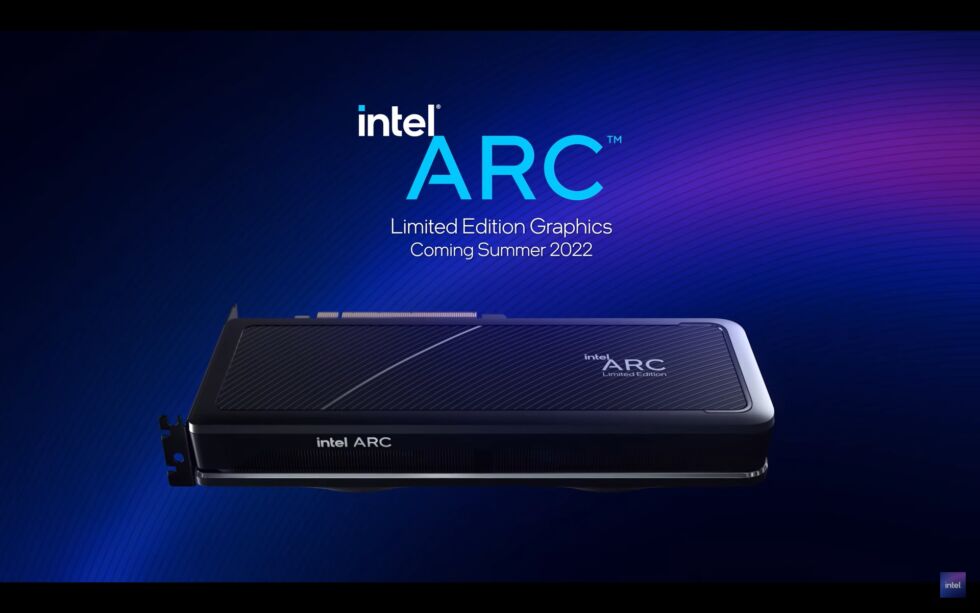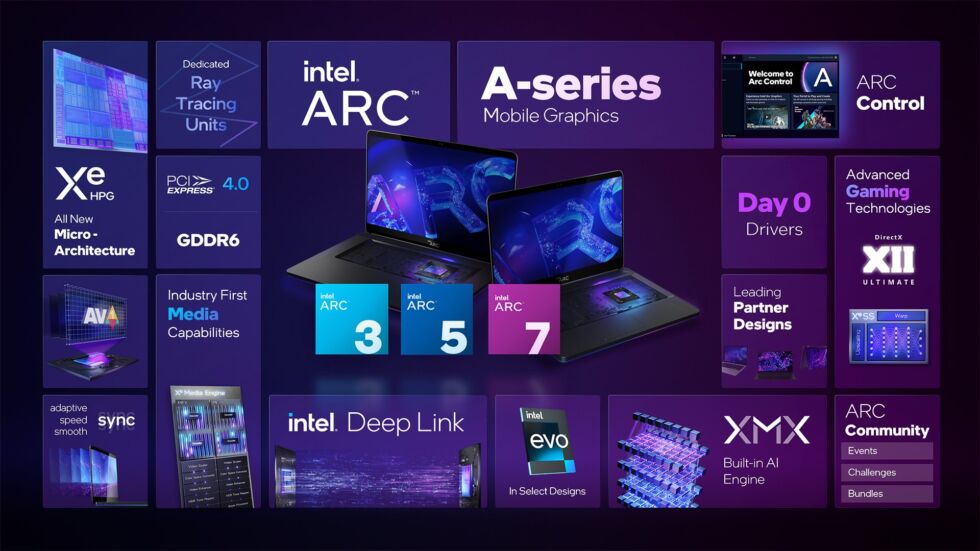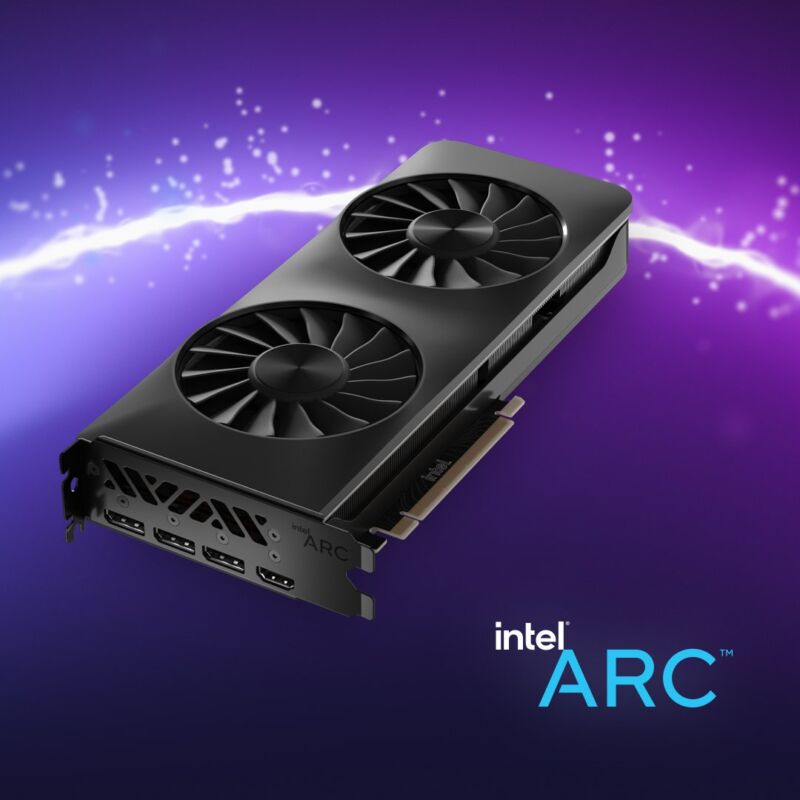Almost a year ago, Intel made a big announcement about its push into the dedicated graphics business. Intel Arc would be the brand name for a new batch of gaming GPUs, pushing far beyond the company's previous efforts and competing directly with Nvidia's GeForce and AMD's Radeon GPUs.
Arc is the culmination of years of work, going back to at least 2017, when Intel poached AMD GPU architect Raja Koduri to run its own graphics division. And while Intel would be trying to break into an established and fiercely competitive market, it would benefit from the experience and gigantic install base that the company had cultivated with its integrated GPUs.
Intel sought to prove its commitment to Arc by showing off a years-long road map, with four separate named GPU architectures already in the pipeline. Sure, the GPUs wouldn't compete with top-tier GeForce and Radeon cards, but they would address the crucial mainstream GPU market, and high-end cards would follow once the brand was more established.
All of that makes Arc a lot more serious than Larrabee, Intel's last effort to break into the dedicated graphics market. Larrabee was canceled late in its development because of delays and disappointing performance, and Arc GPUs are actual things that you can buy (if only in a limited way, for now). But the challenges of entering the GPU market haven't changed since the late 2000s. Breaking into a mature market is difficult, and experience with integrated GPUs isn't always applicable to dedicated GPUs with more complex hardware and their own pool of memory.
Regardless of the company's plans for future architectures, Arc's launch has been messy. And while the company is making some efforts to own those problems, a combination of performance issues, timing, and financial pressures could threaten Arc's future.
Early turbulence
A year after its announcement, it seems that Arc is already on shaky ground. Intel has proven characteristically incapable of meeting its initial launch estimates, just barely managing to pull off a paper launch of two low-end laptop GPUs in Q1 (the original launch window) and failing to follow up with widely available desktop cards in Q2. The company has been very public about its struggles with drivers, which are hurting the cards' performance in older but still widely played games. And the graphics division is losing money at a time when revenue is tumbling across Intel.
And that's just what is happening in public. A report from the German-language Igor's Lab claims that Intel's board partners (the ones who would be putting the Arc GPU dies on boards, packaging them, and shipping them out) and the OEMs who would be putting Arc GPUs into their prebuilt computers are getting frustrated with the delays and lack of communication.
A long, conspiratorial video from YouTuber Moore's Law is Dead goes even farther, suggesting (using a combination of "internal sources" and speculation) that people in Intel's graphics division are "lying" to consumers and others in the company about the state of the GPUs, that the first-generation Alchemist architecture has fundamental performance-limiting flaws, and that Intel is having internal discussions about discontinuing Arc GPUs after the second-generation "Battlemage" architecture.
We've contacted Intel and several GPU manufacturers to see if they had anything to share on the matter; the short version is no—Intel has no news on release dates. Asus says it "[doesn't] currently have anything in the pipeline for Intel Arc on the North America side," and other companies haven't responded yet. For his part, Intel graphics VP Raja Koduri has said publicly that "we are very much committed to our roadmap" and that there will be "more updates from us this quarter" and "four new product lines by the end of the year."
How is Arc shaping up?

The first Arc GPUs were initially targeted for early 2022, and Intel managed to announce a pair of low-end 300-series laptop GPUs at the tail end of March. To date, the number of those laptops that is actually available for purchase is small, and no one in the US has been able to buy anything else. A desktop version of the 1080p-focused Arc A380 has appeared in China, though, and a few publications have managed to import and test it.
We can only infer so much about the performance of higher-end Arc cards based on these two entry-level GPUs, but early reports have been mixed at best. On the positive side, the low-end Arc GPUs are an improvement over integrated graphics, and the A380 can trade blows with sub-$200 GPUs like AMD's Radeon RX 6400 and Nvidia's GeForce GTX 1650. Intel's support for hardware-accelerated encoding and decoding of the royalty-free AV1 video codec could also be a big deal for streamers, and Intel is ahead of Nvidia and AMD here. The bad news is that performance is maddeningly inconsistent, with wild swings between one game and the next, and some of the GPUs the A380 is running neck-and-neck with are years old.
The A380 has also exhibited quirks that are likely to be present across the Arc lineup. The GPU's performance takes a dive when used in a system without Resizable Base Address Memory (alternatively referred to as Resizable BAR, ReBAR, Smart Access Memory, or SAM by various GPU and motherboard makers). Resizable BAR, which allows the CPU to access the GPU's entire pool of VRAM instead of addressing it in 256MB chunks, can help at the margins with newer GeForce and Radeon GPUs. But Arc GPUs seem to need it to perform well in a way that isn't true for other cards. Almost all modern motherboards do support Resizable BAR, and some older boards can do it after a BIOS update, but older systems and OEM-built PCs with limited BIOSes may not be able to enable it.
Arc's performance is also worst when playing older games that don't support the DirectX12 or Vulkan APIs, pointing to one huge issue that Intel has openly acknowledged: The company is struggling with its GPU drivers.
Drivers are definitely an issue
Intel's (generally pretty bad) quarterly earnings report last week showed that its graphics group had lost a little over $500 million in the second quarter alone, partly because of "roadmap investment" (i.e., development of future products) and partly because of "inventory reserves" (i.e., hardware that has been manufactured but has not been sold).
Intel CEO Pat Gelsinger has publicly blamed the company's drivers for its Arc GPU delays. While he says the drivers are "catching up and getting better," early versions that tried to "leverage the integrated graphics software stack" were "wholly inadequate for the performance levels, gaming compatibility, etc. that we needed."
That's likely the reason why Intel decided to bifurcate its graphics driver package in late July. You still only download one big package to support every Intel GPU released between late 2015 and the present day, but the package now contains one "legacy" driver to support older Intel HD and UHD-grade integrated GPUs and a separate, more frequently updated driver for dedicated GPUs and newer Intel Iris Xe-class integrated GPUs.
There are signs that some performance issues can be worked out in software, as when a minor change to their Linux driver hugely boosted Arc cards' ray tracing performance. But you can still see signs of the drivers' immaturity in the company's "three-tier strategy," which makes different performance promises based on whether a game includes Arc-specific optimizations (Tier 1), whether it uses newer APIs like DirectX12 and Vulkan where Arc performs reasonably well with no optimizations (Tier 2) and whether it uses older DirectX versions where Arc performs poorly (Tier 3).
The problems with older APIs might be fixable in time, but they aren't necessarily low-hanging fruit, and Arc's performance will likely continue to vary from game to game for quite a while. AMD has been in the graphics business for decades if you include the graphics division's years as ATI, and this year alone, it has released drivers specifically to improve performance with older APIs like DirectX11 and OpenGL. These things can take years to fix, not months.
Intel is trying to own the problems

To its credit, Intel has openly acknowledged the problem that Arc has with pre-DirectX12 games, not just in slickly produced PR videos but by allowing its marketing team to conduct a charm offensive on popular tech YouTube channels like Linus Tech Tips and Gamers Nexus.
In LTT's case, this means jokes, fast edits, and sly winks to make viewers feel like they're getting secret, under-the-table information, even though Intel PR is standing over the channel's shoulder. The videos give Intel a way to own and partially defuse criticism of Arc's performance in older games. It's also a way to suggest that the company has nothing to hide.
As a PR strategy, it's great. It's the Domino's Pizza gambit: when your product's issues are impossible to ignore, you can build more trust and buy yourself a little goodwill and time by issuing loud, public mea culpas and owning the problem rather than ignoring it. And the tech-tubers have seemed receptive to Intel's framing—sure, performance in older games is all over the place, but it just means we're going to get great performance for the price in newer games.
Intel is also saying that Arc will be priced based on how the cards perform in those "Tier 3" games. If an Arc GPU runs a DirectX12 game like an RTX 3070 would and a DirectX11 game like an RTX 3050 would, Intel is saying that the card will be priced more like a 3050 than a 3070. Everyone likes a good deal, and if Intel can dramatically undercut Nvidia and AMD on pricing, it will probably find some takers, even if those cards are flawed in other ways.
But past is prologue
Whether the issues are being caused by hardware, software, or some combination of the two, Intel's leadership and shareholders may not have infinite patience for the graphics team's problems. And we've seen this play out before with Intel multiple times.
The company is under a lot of pressure to improve its execution after giving up a years-long manufacturing lead to the likes of TSMC and Samsung and losing PC and server market share to AMD's Ryzen chips. It would be one thing for the graphics division to lose $500 million in one quarter if the rest of the company was doing great, but that isn't the case right now. Issues like softening demand for PCs and stiff competition from AMD are leading to big bites being taken out of Intel's consumer PC and server business.
Regardless of whether sensational YouTuber claims of the Arc lineups' imminent cancellation are true (and we likely won't know for sure until and unless Intel itself makes an announcement), it's a lot of time and money to invest at a time when the most profitable divisions of the company are stumbling.
That's doubly true for an extant, sometimes-volatile market segment with entrenched competitors. If Intel enters the dedicated GPU market with products that are already behind the competition in both performance and power consumption, it will be difficult to claw market share away from them without either undercutting them on price or catching up. Selling low-margin "budget options" isn't likely to make a ton of money, especially not compared to the potential upside from the company's nascent foundry business. And catching up with a moving target is difficult; just look at how Intel's efforts to break into smartphone SoCs and cellular modems went last decade (the short version is that the company struggled to break through and eventually cut its losses).
And timing is everything
Compounding all of Arc's problems is the issue of timing.
In late 2021 and into early 2022, it seemed like Intel could be entering the dedicated GPU market at exactly the right time. Widespread shortages and committed scalpers were making GPUs from Nvidia and AMD nearly impossible to buy at their listed retail prices. If Intel could show up with dedicated GPUs that leveraged its experience with integrated GPUs—and those dedicated GPUs could be even remotely competitive with Nvidia's and AMD's midrange performance and power use—gamers would be desperate enough to get their hands on any graphics card that they'd be willing to give Intel a shot.
Fortunately for gamers but unfortunately for Intel, that moment appears to have passed. GPUs are back in stock at most major retailers and (depending on the card) are finally drifting back to or even under their original MSRPs. And with next-generation Nvidia and AMD GPUs looming later this year, the first-gen Arc cards will only get less competitive.
The next couple of years will be crucial for Intel's GPUs. Better drivers, aggressive pricing, and the Battlemage architecture could all help Intel find a foothold, establishing a third competitor in consumer and workstation GPUs and making the segment more competitive. Or Arc could end up going the way of Larrabee, a once-promising project that just didn't work out the way it was supposed to.
Listing image by Intel



3175x175(CURRENT).thumb.jpg.b05acc060982b36f5891ba728e6d953c.jpg)
Recommended Comments
There are no comments to display.
Join the conversation
You can post now and register later. If you have an account, sign in now to post with your account.
Note: Your post will require moderator approval before it will be visible.